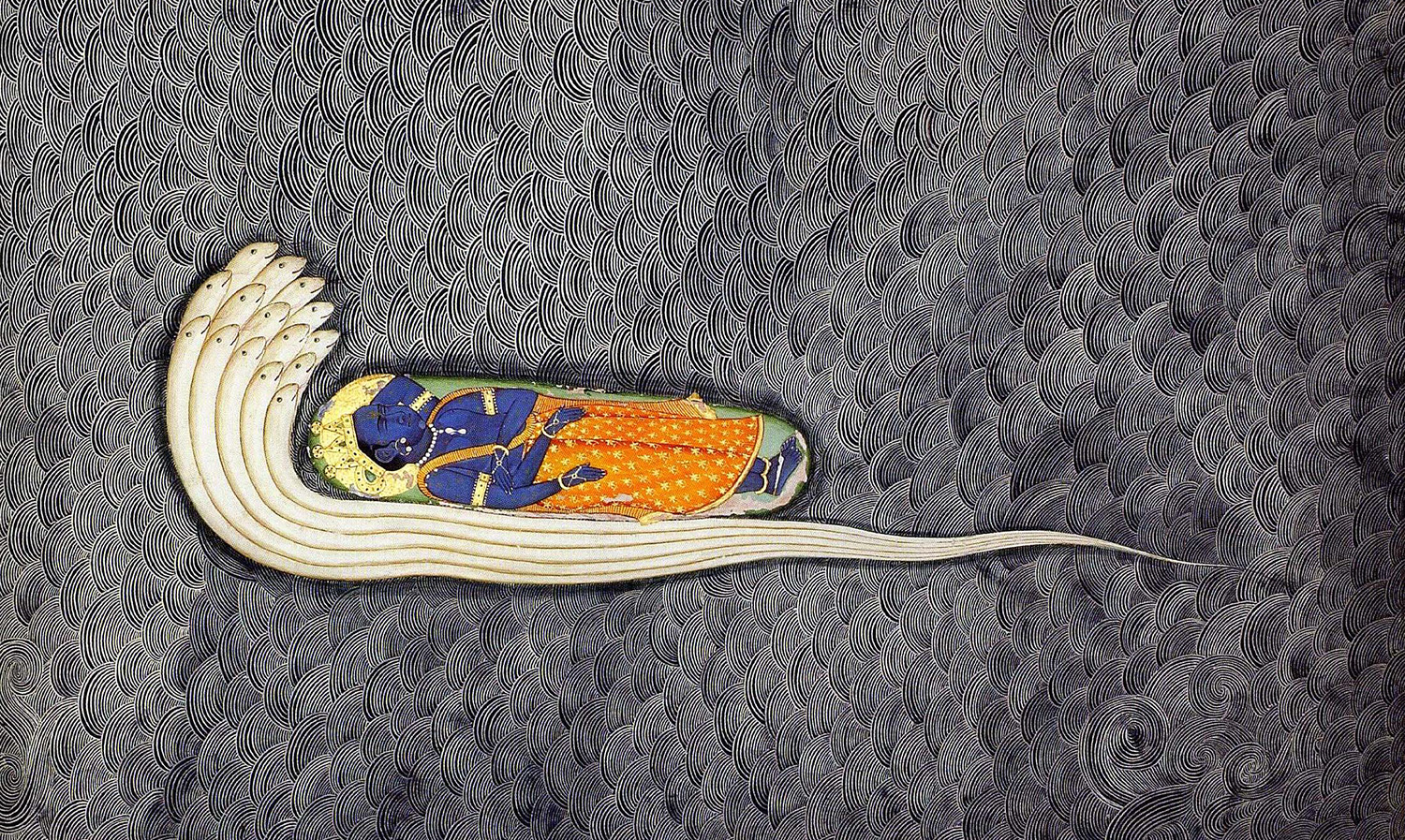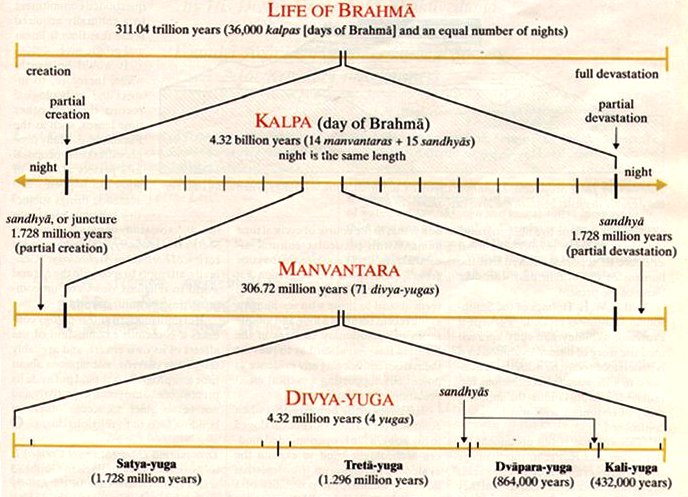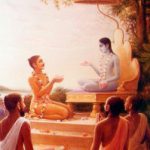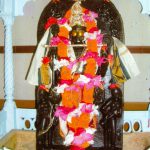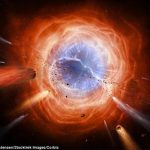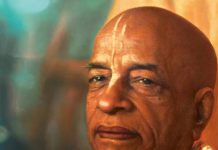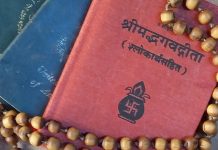“After a cycle of universal dissolution, the Supreme Being decides to recreate the cosmos so that we souls can experience worlds of shape and solidity. Very subtle atoms begin to combine, eventually generating a cosmic wind that blows heavier and heavier atoms together. Souls depending on their karma earned in previous world systems, spontaneously draw to themselves atoms that coalesce into an appropriate body.” – The Prashasta Pada.
Hinduism’s understanding of time is as grandiose as time itself. While most cultures base their cosmologies on familiar units such as few hundreds or thousands of years, the Hindu concept of time embraces billions and trillions of years. The Puranas describe time units from the infinitesimal truti, lasting 1/1,000,0000 of a second to a mahamantavara of 311 trillion years. Hindu sages describe time as cyclic, an endless procession of creation, preservation and dissolution. Scientists such as Carl Sagan have expressed amazement at the accuracy of space and time descriptions given by the ancient rishis and saints, who fathomed the secrets of the universe through their mystically awakened senses.
As in modern physics, Hindu cosmology envisaged the universe as having a cyclical nature. The end of each kalpa brought about by Shiva’s dance is also the beginning of the next. Rebirth follows destruction.
The transcendence of time is the aim of every Indian spiritual tradition. Time is often presented as an eternal wheel that binds the soul to a mortal existence of ignorance and suffering. “Release” from time’s fateful wheel is termed moksha, and an advanced ascetic may be called kala-attita (‘ he who has transcended time’).
Hindus believe that the universe is without a beginning (anadi= beginning-less) or an end (ananta = end-less). Rather the universe is projected in cycles.
Time immemorial is measured in cycles called Kalpas. A Kalpa is a day and night for Brahma, the Lord of Creation. After each Kalpa, there is another Kalpa. Each Kalpa is composed of 1,000 Maha Yugas.
A Kalpa is thus equal to 4.32 billion human years. Kirtha Yuga or Satya yuga (golden or truth age) is 1,728,000 years; Treta yuga is 1,296,000 years; Dvapara yuga is 864,000 years; and Kali Yuga is 432,000 years. Total duration of the four yugas is called a maya-yuga.
One Maha Yuga is 4,32 million years.
Krita or Satya golden age 1,728,000 years
Treta silver age 1,296,000 years
Dvapara copper age 864,000 years
Kali iron age 432,000 years
A Brahma, or Lord of Creation, lives for one hundred Brahma years (each of made up of 360 Brahma days). After that he dies. So a Brahma lives for 36,000 Kalpas, or 36,000 x 2,000 x 4,30,000 human years – i.e., a Brahma lives for 311.4 trillion human years. After the death of each Brahma, there is a Mahapralaya or Cosmic deluge, when all the universe is destroyed. Then a new Brahma appears and creation starts all over again.
Time in Hindu mythology is conceived as a wheel turning through vast cycles of creation and destruction (pralaya), known as kalpa. In the words of famous writer, Joseph Campbell:
“The Hindus with their grandiose Kalpas and their ideas of the divine power which is beyond all human category (male or female). Not so alien to the imagery of modern science that it could not have been put to acceptable use.”
According to Guy Sorman, visiting scholar at Hoover Institution at Stanford and the leader of new liberalism in France:
“Temporal notions in Europe were overturned by an India rooted in eternity. The Bible had been the yardstick for measuring time, but the infinitely vast time cycles of India suggested that the world was much older than anything the Bible spoke of. It seem as if the Indian mind was better prepared for the chronological mutations of Darwinian evolution and astrophysics.”
Huston Smith a philosopher, most eloquent writer, world-famous religion scholar who practices Hatha Yoga. Has taught at MIT and is currently visiting professor at Univ. of California at Berkley. Smith has also produced PBS series. He has written various books, The World’s Religions, “Science and Human Responsibility”, and “The Religions of Man” says:
“Philosophers tell us that the Indians were the first ones to conceive of a true infinite from which nothing is excluded. The West shied away from this notion. The West likes form, boundaries that distinguish and demarcate. The trouble is that boundaries also imprison – they restrict and confine.”
“India saw this clearly and turned her face to that which has no boundary or whatever.” “India anchored her soul in the infinite seeing the things of the world as masks of the infinite assumes – there can be no end to these masks, of course. If they express a true infinity.” And It is here that India’s mind boggling variety links up to her infinite soul.”
“India includes so much because her soul being infinite excludes nothing.” It goes without saying that the universe that India saw emerging from the infinite was stupendous.”
“While the West was still thinking, perhaps, of 6,000 years old universe – India was already envisioning ages and eons and galaxies as numerous as the sands of the Ganges. The Universe so vast that modern astronomy slips into its folds without a ripple.”
Dr. Carl Sagan in his book Broca’s Brain: Reflections on the Romance of Science, remarks:
“Immanuel Velikovsky (the author of Earth in Upheaval) in his book Worlds in Collision, notes that the idea of four ancient ages terminated by catastrophe is common to Indian as well as to Western sacred writing.
However, in the Bhagavad Gita and in the Vedas, widely divergent numbers of such ages, including an infinity of them, are given; but, more interesting, the duration of the ages between major catastrophes is specified as billions of years. .. ”
“The idea that scientists or theologians, with our present still puny understanding of this vast and awesome cosmos, can comprehend the origins of the universe is only a little less silly than the idea that Mesopotamian astronomers of 3,000 years ago – from whom the ancient Hebrews borrowed, during the Babylonian captivity, the cosmological accounts in the first chapter of Genesis – could have understood the origins of the universe. We simply do not know.
The Hindu holy book, the Rig Veda (X:129), has a much more realistic view of the matter:
“Who knows for certain? Who shall here declare it?
Whence was it born, whence came creation?
The gods are later than this world’s formation;
Who then can know the origins of the world?
None knows whence creation arose;
And whether he has or has not made it;
He who surveys it from the lofty skies,
Only he knows- or perhaps he knows not.”
Hinduism is the only religion that propounds the idea of life-cycles of the universe. It suggests that the universe undergoes an infinite number of deaths and rebirths. Hinduism, according to Carl Sagan, “… is the only religion in which the time scales correspond… to those of modern scientific cosmology.
Long before Aryabhata (6th century) came up with this awesome achievement, apparently there was a mythological angle to this as well — it becomes clear when one looks at the following translation of Bhagavad Gita (part VIII, lines 16 and 17),
“All the planets of the universe, from the most evolved to the most base, are places of suffering, where birth and death takes place. But for the soul that reaches my Kingdom, O son of Kunti, there is no more reincarnation. One day of Brahma is worth a thousand of the ages [yuga] known to humankind; as is each night.”
Thus each kalpa is worth one day in the life of Brahma, the God of creation. In other words, the four ages of the mahayuga must be repeated a thousand times to make a “day ot Brahma”, a unit of time that is the equivalent of 4.32 billion human years, doubling which one gets 8.64 billion years for a Brahma day and night. This was later theorized (possibly independently) by Aryabhata in the 6th century. The cyclic nature of this analysis suggests a universe that is expanding to be followed by contraction… a cosmos without end. This, according to modern physicists is not an impossibility.
Count Maurice Maeterlinck (1862-1949) was a Belgian writer of poetry, a wide variety of essays. He won the 1911 Nobel Prize for literature. In his book Mountain Paths, says:
“he falls back upon the earliest and greatest of Revelations, those of the Sacred Books of India with a Cosmogony which no European conception has ever surpassed.”
In Hindu thought, interspersed between linear, time-limited existences lie timeless intervals of non-existence. The creation hymn of the Hindus, Nasadiya-sukta of Rig-Veda, affirms an absolute beginning of things and describes the origin of the universe as being beyond the concepts of existence and non-existence
“The Hindu … pictured the universe as periodically expanding and contracting and gave the name Kalpa to the time span between the beginning and the end of one creation. The scale of this space or time is indeed staggering. It has taken more than two thousand years to come up again with a similar concept.”
Hindu culture had this unique vision of the infiniteness of time as well as the infinity of space. When modern astronomy deals with billion of years, Hindu creation concepts deal with trillions of years. Vedanta upholds the idea that creation is timeless, having no beginning in time. Each creation and dissolution follows in sequence. The whole cosmos exists in two states — the unmanifested or undifferentiated state and the manifested or differentiated state.
Princeton University’s Paul Steinhardt and Cambridge University’s Neil Turok, have recently developed The Cyclical Model.
They have just fired their latest volley at that belief, saying there could be a timeless cycle of expansion and contraction. It’s an idea as old as Hinduism, updated for the 21st century. The theorists acknowledge that their cyclic concept draws upon religious and scientific ideas going back for millennia — echoing the “oscillating universe” model that was in vogue in the 1930s, as well as the Hindu belief that the universe has no beginning or end, but follows a cosmic cycle of creation and dissolution.
The French historian Louis Jacolliot says, “Here to mock are conceit, our apprehensions, and our despair, we may read what Manu said, perhaps 10,000 years before the birth of Christ about Evolution:
‘ The first germ of life was developed by water and heat.’ (Book I, sloka 8,9 )
‘ Water ascends towards the sky in vapors; from the sun it descends in rain, from the rains are born the plants, and from the plants, animals.’ (Book III, sloka 76).
Sir John Woodroffe, (1865-1936) the well known scholar, Advocate-General of Bengal and sometime Legal Member of the Government of India. He served with competence for eighteen years and in 1915 officiated as Chief Justice. He has said:
“Ages before Lamarck and Darwin it was held in India that man has passed through 84 lakhs (8,400,000) of birth as plants, animals, as an “inferior species of man” and then as the ancestor of the developed type existing to-day.
Thus, in Hinduism, science and religion are not opposed fundamentally, as they often seem to be in the West, but are seen as parts of the same great search for truth and enlightenment that inspired the sages of Hinduism. Fundamental to Hindu concept of time and space is the notion that the external world is a product of the creative play of Maya (illusion).
“To the philosophers of India, Relativity is no new discovery, just as the concept of light years is no matter for astonishment to people used to thinking of time in millions of kalpas, (A kalpa is about 4,320,000 years). The fact that the wise men of India have not been concerned with technological applications of this knowledge arises from the circumstance that technology is but one of innumerable ways of applying it.
“It is, indeed, a remarkable circumstance that when Western civilization discovers Relativity it applies it to the manufacture of atom-bombs, whereas Oriental civilization applies it to the development of new states of consciousness.” (Frederic Spiegelberg)
“The Hindu religion is the only one of the world’s great faiths dedicated to the idea that the Cosmos itself undergoes an immense, indeed an infinite, number of deaths and rebirths. It is the only religion in which the time scales correspond, to those of modern scientific cosmology.
“It is the clearest image of the activity of God which any art or religion can boast of.” Modern physics has shown that the rhythm of creation and destruction is not only manifest in the turn of the seasons and in the birth and death of all living creatures, but also the very essence of inorganic matter.
Fritjof Capra, Austrian-born famous theoretical high-energy physicist and ecologist wrote:
“Modern physics has thus revealed that every subatomic particle not only performs an energy dance, but also is an energy dance; a pulsating process of creation and destruction. The dance of Shiva is the dancing universe, the ceaseless flow of energy going through an infinite variety of patterns that melt into one another’’. For the modern physicists, then Shiva’s dance is the dance of subatomic matter. As in Hindu mythology, it is a continual dance of creation and destruction involving the whole cosmos; the basis of all existence and of all natural phenomenon. Hundreds of years ago, Indian artists created visual images of dancing Shivas in a beautiful series of bronzes. In our times, physicists have used the most advanced technology to portray the patterns of the cosmic dance.”
Nancy Wilson Ross (1901 -1986) made her first trip to Japan, China, Korea and India in 1939. She was the author of several books including The World of Zen and Time’s Left Corner. Miss Ross lectured on Zen Buddhism at the Jungian Institute in Zurich. She served on the board of the Asia Society of New York which was founded by John D. Rockefeller III since its founding in 1956 and was on the governing board of the India Council. In private life she was known as Mrs. Stanley Young.
She has written:
“Anachronistic as this labyrinthine mythology may appear to the foreign mind, many of India’s ancient theories about the universe are startlingly modern in scope and worthy of a people who are credited with the invention of the zero, as well as algebra and its application of astronomy and geometry; a people who so carefully observed the heavens that, in the opinion of Monier-Williams, they determined the moon’s synodical revolution much more correctly than the Greeks.”
” Many hundreds of years before those great European pioneers, Galileo and Copernicus, had to pay heavy prices in ridicule and excommunication for their daring theories, a section of the Vedas known as the Brahmanas contained this astounding statement:
“The sun never sets or rises. When people think the sun is setting, he only changes about after reaching the end of the day and makes night below and day to what is on the other side. Then, when people think he rises in the morning, he only shifts himself about after reaching the end of the day night, and makes day below and night to what is on the other side. In truth, he does not see at all.”
“The Indians, whose theory of time, is not linear like ours – that is, not proceeding consecutively from past to present to future – have always been able to accept, seemingly without anxiety, the notion of an alternately expanding and contracting universe, an idea recently advanced by certain Western scientists. In Hindu cosmology, immutable Brahman, at fixed intervals, draws back into his beginningless, endless Being the whole substance of the living world. There then takes place the long “sleep” of Brahman from which, in course of countless aeons, there is an awakening, and another universe or “dream” emerges. ”
“This notion of the sleeping and waking, or contracting and expanding, of the Life Force, so long a part of Hindu cosmology, has recently been expressed in relevant terms in an article written for a British scientific journal by Professor Fred Hoyle, Britain’s foremost astronomer. ”
Lord Vishnu is said to rest in the coils of Ananta, the great serpent of Infinity, while he waits for the universe to recreate itself.
“Plainly, contemporary Western science’s description of an astronomical universe of such vast magnitude that distances must be measured in terms as abstract as light-years is not new to Hinduism whose wise men, millennia ago, came up with the term kalpa to signify the inconceivable duration of the period elapsing between the beginning and end of a world system.
“It is clear that Indian religious cosmology is sharply at variance with that inherited by Western peoples from the Semites. On the highest level, when stripped of mythological embroidery, Hinduism’s conceptions of space, time and multiple universes approximate in range and abstraction the most advanced scientific thought. ” (Nancy Wilson Ross)
Dr. Heinrich Zimmer (1890-1943), the great German Indologist, a man of penetrating intellect, the keenest esthetic sensibility observed:
“In one of the Puranic accounts of the deeds of Vishnu in his Boar Incarnation or Avatar, occurs a casual reference to the cyclic recurrence of the great moments of myth. The Boar, carrying on his arm the goddess Earth whom he is in the act of rescuing from the depths of the sea, passingly remarks to her:
“Every time I carry you this way….”
For the Western mind, which believes in single, epoch-making, historical events (such as, for instance, the coming of Christ) this casual comment of the ageless god has a gently minimizing, annihilating effect.”
Professor Arthur Holmes (1895-1965) geologist, professor at the University of Durham. He writes regarding the age of the earth in his great book, The Age of Earth (1913) as follows:
“Long before it became a scientific aspiration to estimate the age of the earth, many elaborate systems of the world chronology had been devised by the sages of antiquity. The most remarkable of these occult time-scales is that of the ancient Hindus, whose astonishing concept of the Earth’s duration has been traced back to Manusmriti, a sacred book.”
When the Hindu calculation of the present age of the earth and the expanding universe could make Professor Holmes so astonished, the precision with which the Hindu calculation regarding the age of the entire Universe was made would make any man spellbound.
The Upanishads developed this spirit of inquiry, and traces of naturalistic and scientific thought in them are quite significant. The Samkhya system, which has been described as the ruling philosophy of pre-Buddhist India and an orthodox system having its roots in the Upanishads, is essentially rational, anti-theistic, and intellectual. According to Richard Garbe, it was in Samkhya doctrine that complete independence and freedom of the human mind was exhibited for the first time in history. Samkhya, probably the oldest Indian philosophical system, furnished the background for the Yoga system, and the early Buddhist biography Lalitavistara includes both Samkhya and Yoga in the curriculum of study for the young Buddha. Samkhya is generally ascribed to Sage Kapila and Yoga to Sage Patanjali. Ideas of natural selection, atomic polarity and evolution.
Like in other ancient civilizations, in Hindu India priests and scientists were often the same persons; the conflict between religion and reason is not the primitive condition but a contingent historical development in post-classical Europe, paralleled to an extent by the stagnation of Muslim culture from the 12th century onwards. The Sankya philosophy of Kapila, in short, is devoted entirely to the systematic, logical, and scientific explanation of the process of cosmic evolution from that primordial Prakriti, or eternal Energy. There is no ancient philosophy in the world which was not indebted to the sankhya system of Kapila. The idea of evolution which the ancient Greeks and neo-Platonists had can be traced back to the influence of this Sankhya school of thought.
Modern people divide the day into 24 hours, the hour – into 60 minutes, the minute – into 60 seconds. Ancient Hindus divided the day in 60 periods, lasting 24 minutes each, and so on and so forth. The shortest time period of ancient Hindus made up one-three-hundred-millionth of a second.
Sayana (c. 1315-1387) was a minister in the court of King Bukka I of the Vijayanagar Empire in South India; he was also a great Vedic scholar who wrote extensive commentaries on several ancient texts. In his commentary on the fourth verse of the hymn 1.50 of the Rig Veda on the sun, he says:
Tatha cha smaryate yojananam sahasre dve dve shate dve cha yogane ekena nimishardhena kramamana namo ‘stu ta iti
“Thus it is remembered: (O Sun), bow to you, you who travers 2,202 yojanas in half a nimesha (Speed of Light)”
Related: Speed of Light in the Vedas


